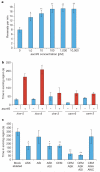A blend of small molecules regulates both mating and development in Caenorhabditis elegans
- PMID: 18650807
- PMCID: PMC2774729
- DOI: 10.1038/nature07168
A blend of small molecules regulates both mating and development in Caenorhabditis elegans
Abstract
In many organisms, population-density sensing and sexual attraction rely on small-molecule-based signalling systems. In the nematode Caenorhabditis elegans, population density is monitored through specific glycosides of the dideoxysugar ascarylose (the 'ascarosides') that promote entry into an alternative larval stage, the non-feeding and highly persistent dauer stage. In addition, adult C. elegans males are attracted to hermaphrodites by a previously unidentified small-molecule signal. Here we show, by means of combinatorial activity-guided fractionation of the C. elegans metabolome, that the mating signal consists of a synergistic blend of three dauer-inducing ascarosides, which we call ascr#2, ascr#3 and ascr#4. This blend of ascarosides acts as a potent male attractant at very low concentrations, whereas at the higher concentrations required for dauer formation the compounds no longer attract males and instead deter hermaphrodites. The ascarosides ascr#2 and ascr#3 carry different, but overlapping, information, as ascr#3 is more potent as a male attractant than ascr#2, whereas ascr#2 is slightly more potent than ascr#3 in promoting dauer formation. We demonstrate that ascr#2, ascr#3 and ascr#4 are strongly synergistic, and that two types of neuron, the amphid single-ciliated sensory neuron type K (ASK) and the male-specific cephalic companion neuron (CEM), are required for male attraction by ascr#3. On the basis of these results, male attraction and dauer formation in C. elegans appear as alternative behavioural responses to a common set of signalling molecules. The ascaroside signalling system thus connects reproductive and developmental pathways and represents a unique example of structure- and concentration-dependent differential activity of signalling molecules.
Figures



Similar articles
-
Ascaroside Pheromones: Chemical Biology and Pleiotropic Neuronal Functions.Int J Mol Sci. 2019 Aug 9;20(16):3898. doi: 10.3390/ijms20163898. Int J Mol Sci. 2019. PMID: 31405082 Free PMC article. Review.
-
Ascaroside expression in Caenorhabditis elegans is strongly dependent on diet and developmental stage.PLoS One. 2011 Mar 15;6(3):e17804. doi: 10.1371/journal.pone.0017804. PLoS One. 2011. PMID: 21423575 Free PMC article.
-
A modular library of small molecule signals regulates social behaviors in Caenorhabditis elegans.PLoS Biol. 2012 Jan;10(1):e1001237. doi: 10.1371/journal.pbio.1001237. Epub 2012 Jan 10. PLoS Biol. 2012. PMID: 22253572 Free PMC article.
-
Sex-specific mating pheromones in the nematode Panagrellus redivivus.Proc Natl Acad Sci U S A. 2012 Dec 18;109(51):20949-54. doi: 10.1073/pnas.1218302109. Epub 2012 Dec 3. Proc Natl Acad Sci U S A. 2012. PMID: 23213209 Free PMC article.
-
Chemical mating cues in C. elegans.Semin Cell Dev Biol. 2014 Sep;33:18-24. doi: 10.1016/j.semcdb.2014.06.002. Epub 2014 Jun 27. Semin Cell Dev Biol. 2014. PMID: 24977334 Review.
Cited by
-
Knowns and unknowns in metabolomics identified by multidimensional NMR and hybrid MS/NMR methods.Curr Opin Biotechnol. 2017 Feb;43:17-24. doi: 10.1016/j.copbio.2016.07.006. Epub 2016 Aug 20. Curr Opin Biotechnol. 2017. PMID: 27552705 Free PMC article. Review.
-
Genetic mapping of variation in dauer larvae development in growing populations of Caenorhabditis elegans.Heredity (Edinb). 2013 Oct;111(4):306-13. doi: 10.1038/hdy.2013.50. Epub 2013 May 29. Heredity (Edinb). 2013. PMID: 23715016 Free PMC article.
-
Darcin: a male pheromone that stimulates female memory and sexual attraction to an individual male's odour.BMC Biol. 2010 Jun 3;8:75. doi: 10.1186/1741-7007-8-75. BMC Biol. 2010. PMID: 20525243 Free PMC article.
-
Ascaroside Pheromones: Chemical Biology and Pleiotropic Neuronal Functions.Int J Mol Sci. 2019 Aug 9;20(16):3898. doi: 10.3390/ijms20163898. Int J Mol Sci. 2019. PMID: 31405082 Free PMC article. Review.
-
PDF-1 neuropeptide signaling regulates sexually dimorphic gene expression in shared sensory neurons of C. elegans.Elife. 2018 Jul 19;7:e36547. doi: 10.7554/eLife.36547. Elife. 2018. PMID: 30024377 Free PMC article.
References
Publication types
MeSH terms
Substances
Grants and funding
LinkOut - more resources
Full Text Sources
Other Literature Sources
Research Materials
Miscellaneous

